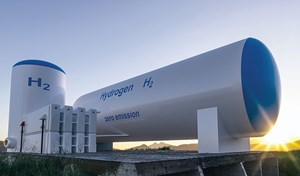(WO) — Wärtsilä Technology Group and WEC Energy Group have successfully tested the capabilities of a Wärtsilä engine running on 25% vol hydrogen-blended fuel. The tests, which were completed in October 2022, were conducted at WEC Energy Group’s 55 MW AJ Mihm power plant in Michigan, USA, using an unmodified Wärtsilä 50SG engine.

Throughout the testing period, the Wärtsilä engine continued to supply power to the grid. This is the largest commercially operated flexible balance engine ever to run on a hydrogen fuel mixture, representing a world achievement.
The Electric Power Research Institute (EPRI) also participated in the tests and led the evaluation of engine performance during the tests. In a recently published report, EPRI’s analysis confirmed the feasibility of blending hydrogen (H2) with natural gas for use in an existing Wärtsilä engine. The results of the demonstration also showed that hydrogen can be safely and reliably handled and used in engine technology.
During three days of continuous testing, the engine’s ability to co-ignite hydrogen blends was successfully demonstrated, showing clear improvements in engine efficiency and reduced greenhouse gas emissions, while meeting emissions of NOx.
An engine load of 95% was achieved with the 25% vol H2 mixture. This verifies the fuel flexibility of Wärtsilä engines without compromising efficiency. Further testing showed that with a 17 vol% H2 mixture, 100% engine load could be achieved.
The EPRI report states that this class of engines can therefore maintain their higher efficiency compared to simple cycle gas turbines. As engines are generally more efficient, their relative CO2 output compared to turbines will also be lower, as was the case in this study.
“These tests provide clear evidence that Wärtsilä’s engine technology can provide future-proof power solutions that make a major contribution to decarbonized operations. The results of tests with a hydrogen/natural gas hybrid fuel mixture have been excellent,” said Anja Frada, Chief Operating Officer of Wärtsilä Energy.
“EPRI is accelerating the deployment of a comprehensive portfolio of clean energy technologies to support a net zero future,” said Neva Espinoza, EPRI’s Vice President of Energy Supply and Low Carbon Resources. “This demonstration project with Wärtsilä and WEC Energy Group is important to show the potential of hydrogen blending in natural gas engines. The learnings from this project will be shared with the energy industry to continue progress towards deep decarbonisation goals “.
As utilities increase their use of renewable energy assets such as wind and solar, opportunities exist to produce hydrogen for long-term energy storage from excess renewable energy. As a fuel, hydrogen burns without producing any carbon species, including CO2. Hydrogen electrolyte manufacturing capacity stands at almost 8 GW/year today, but could exceed 60 GW/year by 2030 according to industry announcements.1
Among other sustainable fuels, hydrogen will be critical to achieving net zero emissions, and is expected to contribute 20% of the total CO2 reduction needed by 2050.2 However, today’s global energy industry is not built for to the adoption of pure hydrogen as safe power. source Therefore, significant investment in market-ready engines that can run on sustainable fuels is crucial to support the transition to net zero. Wärtsilä is pioneering the adoption of hydrogen as a viable fuel through the advanced development and testing of flexible fuel engines.


